|
|
|
Sort Order |
|
|
|
Items / Page
|
|
|
|
|
|
|
| Srl | Item |
| 1 |
ID:
127189
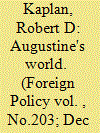

|
|
|
| 2 |
ID:
109164
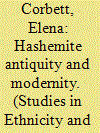

|
|
|
|
|
| Publication |
2011.
|
| Summary/Abstract |
Owing to a range of economic policies and internal and external political relations, King Abdullah II of Jordan has a charisma problem. The ongoing political upheaval in the country began with his dissolution of Parliament in late 2009, in the absence of which he and his ministers promulgated a series of Temporary Laws to push policies that Parliament would not abide. Since then, there has been an election, an array of sackings and reshufflings of various officials, and promises of reform, all in an attempt to mitigate this personal charisma deficit and control the growing and increasingly vehement mobilisation against unpopular policies. Since the king assumed the throne in 1999, visual cues, including giant flags, slogans, ad campaigns, and images of the monarch have been deployed to the same end. This article discusses a different kind of visual cue, Amman's public park known as the King Hussein Gardens, and specifically its component known as the Historical Passageway. The Passageway is a nearly half-kilometre long monument adding - for the first time - a comprehensive view of Jordan's archaeological past to its modern history. In doing so, novel nuances are meant to become part of a complex national narrative that the Hashemite monarchs have developed and tweaked since the days of the Mandate.
|
|
|
|
|
|
|
|
|
|
|
|
|
|
|
|
| 3 |
ID:
144717
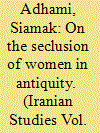

|
|
|
|
|
| Summary/Abstract |
Summary: The study of the feminine in ancient Iran is an area which deserves much greater attention than it has thus far received. By utilizing a number of primary sources, textual and otherwise, a few observations are offered here which concern the rites of women through the centuries. These evolving rites, which are described by the doctors of the then-dominant religion of Zarathustra, deal with the preservation of purity through seclusion of women in a world which is under constant attack from the demonic, polluting forces. Throughout the essay, the different means of fighting this battle are explored and suggestions for further research in the field are made.
|
|
|
|
|
|
|
|
|
|
|
|
|
|
|
|
| 4 |
ID:
187344
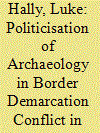

|
|
|
|
|
| Summary/Abstract |
Within contemporary developments of Asian regional security, a core undertone of conflict catalysts and motivations for territorial claims is directly motivated through archaeological findings. These findings include artefacts and settlements, which are utilised to justify political and territorial claims in the region. This overlooked factor will be analysed using three regional case studies through an archaeological and security studies lens. The research aims to further understand Asia Pacific regional security and political disputes and reflect conflict motivation undertones of each interacting nation-state. The article assesses core case studies of Chinese claims in the South China Sea, Japanese and Korean island claims, and Thai-Cambodian temple disputes. The research will analyse how site evidence becomes politicised to justify territorial claims in Asia- Pacific. Through interdisciplinary research, the article will conclude with a greater understanding of assessing conflict development and motivations between state actors in the Asia Pacific region.
|
|
|
|
|
|
|
|
|
|
|
|
|
|
|
|
| 5 |
ID:
107297
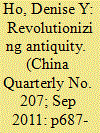

|
|
|
|
|
| Publication |
2011.
|
| Summary/Abstract |
This article examines the response of Shanghai's cultural bureaucracy during the Attack on the Four Olds, the Red Guard repudiation of old culture launched in the early years of China's Cultural Revolution (1966-76). It focuses on how local officials, acting in a space created by the Central Cultural Revolution Group and the Shanghai Revolutionary Committee, worked to control the damage wrought by the political campaign and justified their activities by adapting the rhetoric of revolution. Based on the archival documents of the Shanghai Bureau of Culture, this article traces the reinvention of the cultural bureaucracy and the subsequent shift in the language of preservation. It argues that during the Cultural Revolution, there was an institutionalized and ideologically legitimated movement to protect historic sites and cultural objects. Faced with the destruction of antiquity, Shanghai officials instead proposed its rectification, defending cultural relics in the name of revolution.
|
|
|
|
|
|
|
|
|
|
|
|
|
|
|
|
|
|
|
|
|